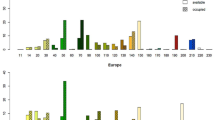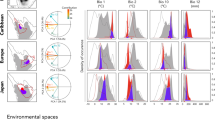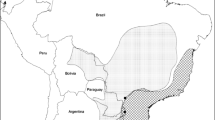Abstract
The raccoon Procyon lotor (Linnaeus 1758) is a native species of North and Central America, but it can be also found as an alien species in parts of Europe and Asia. The raccoon’s flexibility and capability in coping with environmental changes have made it the most successful invader compared with other species. In 1991, a raccoon was recorded in Iran for the first time. Since then, knowledge about the distribution, expansion range, and influences of this species on native ecosystem has remained unclear. The importance of environmental variables for the distribution of raccoons might vary widely across different spatial resolutions; therefore, we developed a robust statistical framework to predict the raccoon distribution across different spatial resolutions in Iran. Our predictions made by species distribution models (ENFA, GARP, and MaxEnt) highlighted the importance of food availability at a small spatial resolution and water resources, settlements, and population density at a large spatial resolution. The models indicate particular areas, mostly located in forests and rangelands near to the Caspian Sea, that can be a potential habitat for raccoons. We observed that the distribution of the raccoon population in Iran almost entirely overlaps with protected areas, which consequently brings about some conflicts with conservation practices and management plans. It is therefore imperative that the local knowledge be strengthened to adequately respond to the threats posed by raccoon invasions of special protected lands.



Similar content being viewed by others
References
Aliev FF, Sanderson GC (1966) Distribution and status of the raccoon in Soviet Union. J Wildl Manage 30:497–502
Barbet-Massin M, Jiguet F, Albert CH, Thuiller W (2012) Selecting pseudo-absences for species distribution models: how, where and how many? Methods Ecol Evol 3:327–338
Boyce MS, Mao JS, Merrill EH, Fortin D, Turner MG, Fryxell J, Turchin P (2003) Scale and heterogeneity in habitat selection by elk in Yellowstone National Park. Ecoscience 10:421–432
Convertino M, Muneepeerakul R, Azaele A, Bertuzzo E, Rinaldo A, Rodriguez-Iturbe I (2009) On neutral meta community patterns of river basins at different scales of aggregation. Water Resour Res 45:W08424
Elith J, Phillips SJ, Hastie T, Dudík M, Chee YE, Yates CJ (2011) A statistical explanation of MaxEnt for ecologists. Divers Distrib 17:43–57
Farashi A, Kaboli M, Karami M (2013) Predicting range expansion of invasive raccoons in northern Iran using ENFA model at two different scales. Ecol Inform 15:96–102
Ferrier S, Watson G (1997) An evaluation of the effectiveness of environmental surrogates and modelling techniques in predicting the distribution of biological diversity. Environment Australia, Canberra
Gehrt SD, Fritzell EK (1998) Resource distribution, female home range dispersion and male spatial interactions: group structure in a solitary carnivore. Anim Behav 55:1211–1227
Graves GR, Rahbek C (2005) Source pool geometry and the assembly of continental avifaunas. Proc Natl Acad Sci USA 102(May):7871–7876
Guisan A, Thuiller W (2005) Predicting species distribution: offering more than simple habitat models. Ecol Lett 8:993–1009
Guisan A, Graham CH, Elith J, Huettmann F, NCEAS Working Group (2007) Sensitivity of predictive species distribution models to change in grain size. Divers Distrib 13:332–340
Hirzel AH, Hausser J, Chessel D, Perrin N (2002) Ecological-niche factor analysis: how to compute habitat-suitability maps without absence data? Ecology 83:2027–2036
Hirzel A, Posse B, Oggier PA, Crettenand Y, Glenz C, Arlettaz R (2004) Ecological requirements of reintroduced species and the implications for release policy: the case of the bearded vulture. Appl Ecol 41:1103–1116
Hohmann U, Bartussek I (2001) Der Waschbar. Oertel and sporer, Reutlin-gen
Hurlbert AH, Jetz W (2007) Species richness, hotspots, and the scale dependence of range maps in ecology and conservation. Proc Natl Acad Sci USA 104:13384–13389
Hutchinson GE (1957) Concluding remarks. Cold Spring Harb Symp Quant Biol 22:415–427
Ikeda T, Asano M, Matoba Y, Abi G (2004) Present status of invasive alien raccoon and its impact in Japan. Global Environ Res 8(2):125–131
Levin SA (1992) The problem of pattern and scale in ecology: the Robert H. MacArthur Award Lecture. Ecology 73:1943–1967
Li B, Ma J, Hu X, Liu H, Zhang R (2009) Potential geographical distributions of the fruit flies Ceratitis capitata, Ceratitis cosyra, and Ceratitis rosa in China. J Econ Entomol 102:1781–1790
Lobo JM, Jiménez-valverde A, Real R (2008) AUC: erratum: predicting species distribution: offering more than simple habitat models. Global Ecol Biogeogr 17:145–151
McGill BJ (2010) Matters of scale. Science 328:575–576
Meyer CB (2007) Does scale matter in predicting species distributions? Case study with the marbled murrelet. Ecol Appl 17(5):1474–1483
Michler FUF, Hohmann U, Stubbe M (2004) Investigation of home range, daytime resting site selection and social system of raccoons Procyon lotor in an urban habitat in Kassel. Beiträge zur Jagd- und Wildforchung, Bd 29:257–273 (In German with English summary)
Naugle DE, Higgins KF, Nusser SM, Johnson WC (1999) Scale-dependent habitat use in three species of prairie wetland birds. Landscape Ecol 14:267–276
Newbury RK, Nelson TA (2007) Habitat selection and movements of raccoons on a grassland reserve managed for imperiled birds. J Mammol 88:1082–1089
Peterson AT, Stockwell DRB, Kluza DA (2002) Distributional prediction based on ecological niche modeling of primary occurrence data. In: Scott JM, Heglund PJ, Morrison ML (eds) Predicting species occurrences: issues of scale and accuracy. Island, Washington, p 617–623
Phillips SJ, Anderson RP, Schapire RE (2006) Maximum entropy modeling of species geographic distributions. Ecol Model 190:231–259
Pineda E, Lobo JM (2012) The performance of range maps and species distribution models representing the geographic variation of species richness at different resolutions. Global Ecol Biogeogr 21:935–944
Rahbek C (2005) The role of spatial scale and the perception of large-scale species richness patterns. Ecol Lett 8:224–239
Robertson MP, Villet MH, Palmer AR (2004) A fuzzy classification technique for predicting species’ distributions: applications using invasive alien plants and indigenous insects. Divers Distrib 10:461–474
Sanderson GC (1987) Raccoon. In: Noval M, Baker JA, Obbard ME, Malloch B (eds) Wild furbearer management and conservation in North America. Ontario Trappers Association, North Bay, pp 486–499
Seo C, Thorne JH, Hannah L, Thuiller W (2009) Scale effects in species distribution models: implications for conservation planning under climate change. Biol Lett 5(1):39–43
Stockwell DRB, Noble IR (1991) Induction of sets of rules from animal distribution data: a robust and informative method of analysis. Math Comput Simulat 33:385–390
Stockwell D, Peters D (1999) The GARP modelling system: problems and solutions to automated spatial prediction. Int J Geogr Inf Sci 13:143–158
Storch D, Marquet P, Brown J (2007) Scaling biodiversity. In: Storch D, Marquet P, Brown J (eds) Ecological reviews. Cambridge University, Cambridge
Stuewer FW (1943) Raccoons: their habits and management in Michigan. Ecol Monogr 13:203–257
Tamis WLM, Van’t Zelfde M (1998) An expert habitat suitability model for the disaggregation of bird survey data: bird counts in the Netherlands downscaled from atlas block to kilometer cell. Landscape Urban Plan 40(4):269–282
Thuiller W, Lafourcade B, Araújo M (2009) Mod operating manual for BIOMOD. Université Joseph Fourier, Laboratoire D’Ecologie Alpine, Grenoble
Tittensor DP, Baco AR, Brewin PE, Clark MR, Consalvey M, Hall-Spencer J, Rowden AA, Schlacher T, Stocks KI, Rogers AD (2009) Predicting global habitat suitability for stony corals on seamounts. J Biogeogr 36:1111–1128
Tong R, Purser A, Guinan J, Unnithan V (2013) Modeling the habitat suitability for deep-water gorgonian corals based on terrain variables. Ecol Inform 13:123–132
Wilson SE, Nielsen CK (2007) Habitat characteristics of raccoon daytime resting sites in southern Illinois. Am Midl Nat 157:175–186
Winter M (2009) Procyon lotor. In: AISIE (ed) Handbook of alien species in Europe, Springer, Dordrecht, p 368
Yamakita T, Nakaoka M (2009) Scale dependency in seagrass dynamics: how does the neighboring effect vary with grain of observation? Popul Ecol 51:33–40
Zeveloff SI (2002) Raccoons: a natural history. Smithsonian Institution, Washington
Author information
Authors and Affiliations
Corresponding author
Rights and permissions
About this article
Cite this article
Farashi, A., Naderi, M. Predicting invasion risk of raccoon Procyon lotor in Iran using environmental niche models. Landscape Ecol Eng 13, 229–236 (2017). https://doi.org/10.1007/s11355-016-0320-8
Received:
Revised:
Accepted:
Published:
Issue Date:
DOI: https://doi.org/10.1007/s11355-016-0320-8




